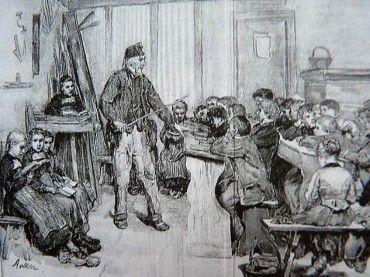Vicarage Dürscheid
Ute Jülich
Version from January 2022
The history
Until the end of the 17th century, there were hardly any public schools in the Bergisch countryside. Only the church maintained so-called
vicarage or sexton schools, which were run by a pastor and supported by the parish. Teaching was the task of the sexton. In Dürscheid, for over two centuries these were the sextons from the Dürscheid family, who lived on their own estate, the Dürscheider Hof, where the children were also taught. Little is known about the content.
During the reign of Duke Karl Theodor, several decrees were issued (1770, 1794) which pushed for better school conditions. In Dürscheid, for example, they wanted to employ a school vicar with a vicar's foundation. After the tenant of the church property "Auf der Mauer" died, plans were made to convert this building into a sexton's office and school.
However, this was not successful, so the
vicarage building was erected instead in 1797. The first school vicar was
Johannes Irlenbusch (1801 - 1821).
He taught school in a room measuring approx. 12 m². It is said that 100 pupils were enrolled, but they were rarely all present. Especially in the summer months, the older children were needed in the fields and many parents were unwilling or unable to pay the (low) school fees. Compulsory schooling was introduced in 1825, but did not initially change the situation much. "School was only held in three winter months and only a few children of better-off parents attended lessons." (H. Pohl)
After the separation of church and state in 1811, the teachers in Dürscheid continued to take over the sexton's duties:
- 1822 - 1842 teacher Alfter
- 1842 Peter Beuth
- 1843 - 1847 Stephan Bürgel
- 1847 - 1869 Heinrich Oessenich Sen. (new school)
In
1846, a new school building was erected on Kirchberg by the building contractor and brick owner Rausch (Blissenbach). It was a brick building designed for the new type of elementary school.
Heinrich Oessenich
was the first teacher at the new school who had received full training at a teacher training college.
He writes in the school chronicle he compiled:
"At the age of 22, I began my work in the new, very spacious school hall, the only regret being that it was rarely filled to half capacity.
When I started, the school roll numbered 110-120 school-age children. It dropped to 52 in 1850 because a few years earlier dysentery had killed many children, especially the younger ones. After that, however, the local population increased so rapidly in just a few years due to the sharp rise in mining and the then flourishing metallurgical industry that by 1857 the school roll already counted 190 - 200 school-age children. "
He continued to serve as sexton until his son took over from him in 1869. Heinrich Oessenich worked as a teacher in Dürscheid for 36 years (1847 - 1883). (He lived from 1847 in the farm of the same name, which was a restaurant from 1910. Later it also became a grocery store and department store, and after the war was known locally as the "Gasthaus Oessenich". The building complex, which always remained in the possession of the Oessenich family, was demolished in 2021).
Several other teachers left their mark on their time through their many years of service:
- 1903 – 1936 teacher Josef Pfeiffer
- 1914 – 1957 Miss Magdalene Lob (grades 1 – 4)
- 1924 – 1955 teacher Peter Limbach (Tambour club)
- 1940 – 1947 teacher Josef Pfeiffer (Orchestra, Maiden Choir, church choir)
The children went to elementary school for 8 years (ages 6 - 14). They learned to read, write and calligraphy, arithmetic, spatial theory, geography, national history, nature description, drawing and singing; the boys were taught gymnastics and the girls needlework. A pupil's equipment included "seven things" (slate, stylus, stylus box, sponge and rag, satchel and primer). Those who did not go straight to work after leaving school could continue on to a commercial school or the Progymnasium.
Until the end of the Second World War, corporal punishment was a common means of education. Boys were beaten with a hazel rod on the buttocks, girls were hit on the fingertips with a ruler. Later, the teacher had to keep a record of who he had punished for which offense. (KSch 12)
In
1958, the old school on Kirchberg had served its purpose and was demolished. Today, the Dürscheid fire department building and the multi-purpose hall stand here. In 1960, the new modern bungalow-style school with south-facing windows and plenty of light in the classrooms was inaugurated next to it.
Addendum:
A water supply was very important for the school and the children. In the vicarage, water could be fetched from the well on the Buchholz farm below the church, which was supplied for little money. For the school on Kirchberg, a water tank was built above the school, which was fed by a water pipe from Buchholzberg to Kirchberg.
Sources:
Pohl, Heinrich St. Nicolaus Dürscheid (1966)
Cüppers/ Michel : Tornister, Tafel, Tintenfass - eine bergische Schulgeschichte
RBK 1968 Cürten, Wilhelm: From the history of the school system in the Bergisch region.
RBK 1980 The Katterbach School Museum
Kürtener Schriften 3 : The water supply of Dürscheid and Spitze
Kürtener Schriften 12: Ministerial decree around 1900 on the punishment of schoolchildren
www. History of the school system in Germany
The literature can be viewed in the local archives of the Kürtener Geschichtsverein.





